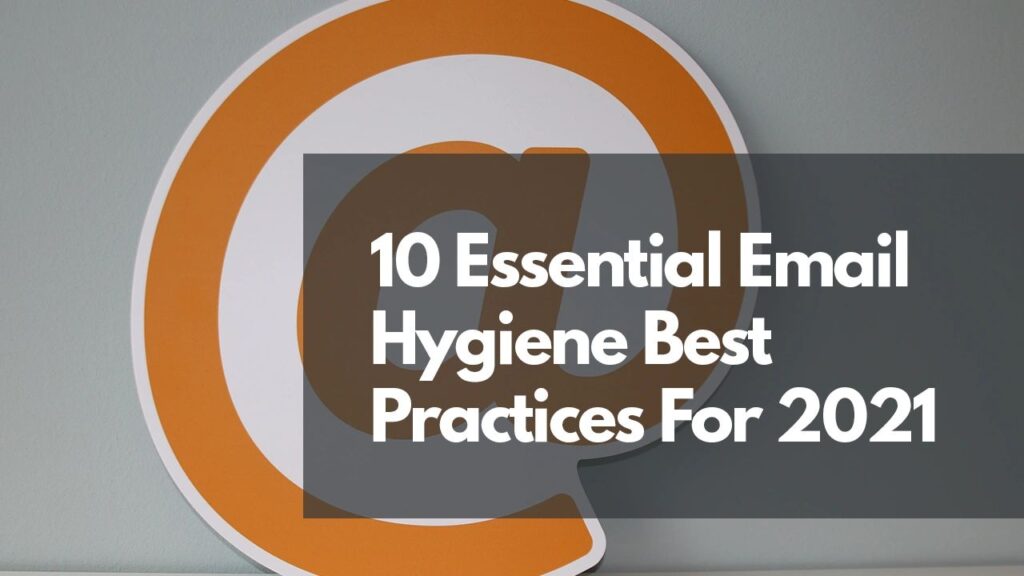Think of email hygiene as dental cleaning and maintenance for your customer email list. If you don’t do it enough–or well–then honey, ya bref gon’ stank and no one’s gonna want to kiss you, or, in this case, do business with you. And that’s a crying shame because you’re worth getting to know.
Trust me, you want a fresh and clean email list because doing so will significantly transform your email marketing efforts, enhance client engagement rates, help you improve your oh-so-important sender reputation, and minimize the chances of your emails landing on “deny lists”.
Did you know that a recent study found 81% of small businesses still rely on email as their primary customer acquisition channel, and 80% rely on it for retention? And some scary statistics show that more than 20% of email registrations contain typos, syntax, domain, and other errors.
Email hygiene, also known as email scrubbing (are you still thinking about teeth?), refers to the process of clearing out inactive, non-engaging, and bounced email addresses from your email list. It’s the most important aspect of email list management because it removes all the information that is useless and only keeps the data that means something to your business.
If you haven’t cleaned up your email list in ages–or never have–here are some tips on how to keep your list accurate and up-to-date so you can finally get the ROI you’ve been waiting for.
10 Essential Email Hygiene Best Practices For 2021:
1. Set Up a Cleaning Schedule and Stick to It
Email hygiene should be a regular practice in your company. But understandably, with all the activities going on in your business daily, it’s easy to forget about something as mundane as your B2B email list’s quality. I recommend that small B2B businesses do at least a monthly review of their entire email list. Larger companies (with larger lists) will have to do a more thorough look-through, so bi-monthly is best practice, ideally with the help of a program or partner. At the end of every year, evaluate whether your cleaning schedule is adequate or needs to be tweaked for efficiency.
2. Avoid Purchasing Email Lists
A common mistake new and old businesses alike make is to purchase existing email lists from third-party vendors. While there are some short-term benefits, they won’t last (alas, nothing good ever does).
Most times, the majority of the email list file, since it isn’t personalized to your needs and business, doesn’t earn you any value, an outcome that doesn’t help your email marketing program one bit.
Focus on creating your own lists by targeting customers who are genuinely interested in what you have to offer. Organic growth based on authentic interest in your business will always pay off in the long run.
3. Remove Invalid and Bounced Emails
Ideally, your email system should be removing hard bounces automatically after two tries. That’s the sweet spot because you don’t want to keep enthusiastically mailing to invalid email addresses. Bounced emails can impact your metrics negatively, particularly your delivery rates. And, of course, everyone wants to be with someone who wants them back.
4. Confirm Email Subscriptions Upon Signup
Although it involves a little more time and work from followers, the double opt-in method is worth it. When your target market users opt to join your email list (yay!), this method of subscription confirmation ensures that subscribers who join your email lists truly want your email. Read: less rejection down the road.
In double opt-in signup, the subscriber first enters their email address on their signup form. They then confirm their subscription once again by clicking on a link in an email that’s sent to them to finish their registration.
As a bonus, it immediately purges unuseful email addresses from your list.
5. Normalize Your Data
Say you have all your data in a nifty Excel sheet. Most likely, the columns are categories, and the rows are the information you have about a specific person.
There are two ways to look at it, and it should be normalized across both, with vertical consistency and horizontal consistency.
6. Horizontal Consistency
The horizontal approach is everything you have about one person (name, email address, contact info, etc).
I’d refer to this as internal consistency: does all the information you have about this contact make sense? If the contact’s name is Jane Finch, but her email address is paul.swickart@jbl.com, there is an issue there. Furthermore, if the email is listed as paul.swickart@jbl.com and then the company is listed as Claridges, then that’s also a horizontal inconsistency. Does Paul work for two companies somehow? It raises a red flag.
7. Vertical Consistency
This is when you look at the data of your list as a big picture and make sure the same kind of data is correctly put into each space.
Are there only email addresses in the email field? Are all the first and last names in the right column, or are they all over the place, for some reason?
So you also have to look at all entries, one at a time, to find and correct inconsistencies. But you also need to check one column type. It’s tedious work, but someone has to do it!
8. Correct Complex Duplicates
Duplicates happen when there are two or more entries in your database for the same person.
In other words, you have Jon Klein and Jonathan Klein (same person) that may be segmented into different groups because your list isn’t clean. Other similar issues can be one same email address with two names: jon.klein@business.com as Jon Klein and Jonathan Klein.
With a few minutes of research, you’ll realize it’s the same person, and you can merge the contact. Voilà!
9. Clean Out People Who Never Engage With You
Even the most squeaky-clean email list will have users who just aren’t interested in your emails and won’t respond—that contact who has never opened a single email you’ve sent and never will. Don’t dwell on it, but don’t be afraid to move on, either. It’s crucial to regularly remove these people from your list, as it hurts your metrics and makes no sense to try to engage with people who just aren’t that into you. I recommend using your email marketing provider to tag people who haven’t opened an email in 90 days. Every 90 days, send out an automated re-engagement campaign; those who open it can move back to your regular list, and those who don’t get culled.
10. Check the Warning Signs
Keep a close eye on your metrics and look out for the signs that your email list requires a cleanup. Your email data quality may be declining if you have low open rates. Plummeting click-through rates (CTR-the percentage of people who have opened your email and then clicked on the link you provide inside) may also indicate a problem. Also, look at your bounce rate, conversion rates, and overall ROI. Each of these factors can trend upwards by giving your email list a good scrubbing.
It’s time to take a good hard look at your email marketing system and make the necessary changes to get it spick and span.
Not sure how to maximize your email marketing strategy? Megan Killion Consulting is an experienced marketing team with experience and expertise in all facets of email, social media campaigns, and more. Book a chat today to get started on addressing your unique business needs and how we could help move your brand forward together.

